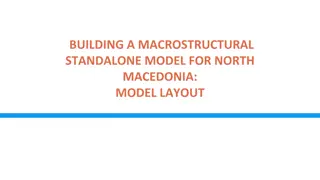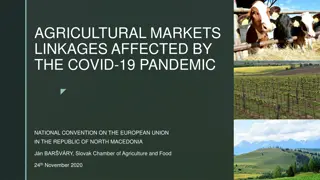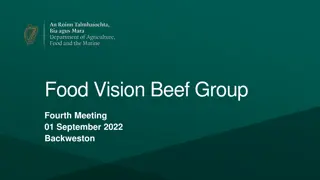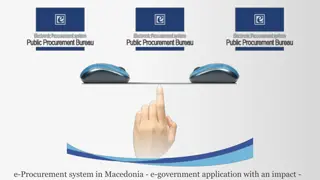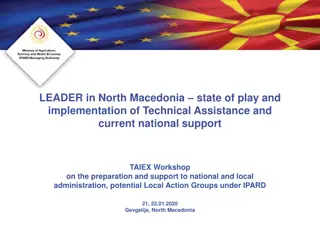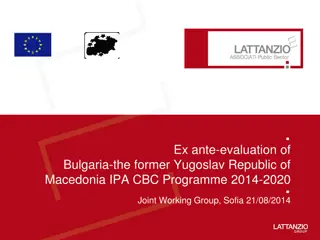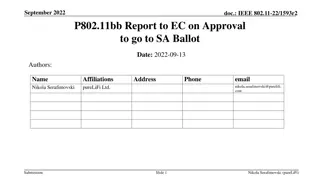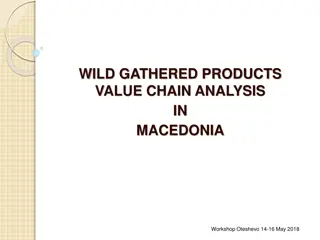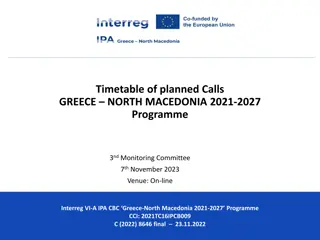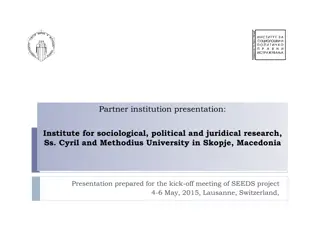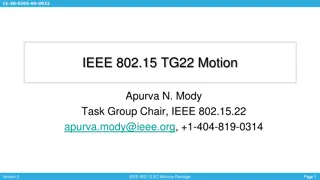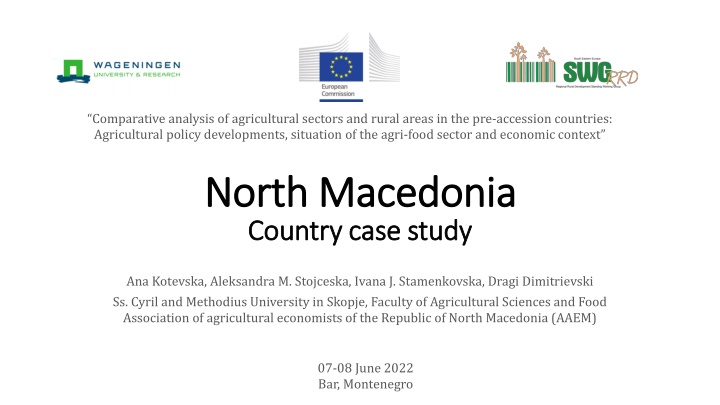
Agricultural Policy Framework and Challenges in North Macedonia
Explore the agricultural policy framework, institutional challenges, and key issues in North Macedonia's agricultural sector. Learn about the linkages between strategic goals, administrative needs, and the utilization of EU funds like IPARD. Discover the efforts towards digitalization, human resource development, and infrastructure upgrades to enhance the agri-food sector.
Download Presentation

Please find below an Image/Link to download the presentation.
The content on the website is provided AS IS for your information and personal use only. It may not be sold, licensed, or shared on other websites without obtaining consent from the author. If you encounter any issues during the download, it is possible that the publisher has removed the file from their server.
You are allowed to download the files provided on this website for personal or commercial use, subject to the condition that they are used lawfully. All files are the property of their respective owners.
The content on the website is provided AS IS for your information and personal use only. It may not be sold, licensed, or shared on other websites without obtaining consent from the author.
E N D
Presentation Transcript
Comparative analysis of agricultural sectors and rural areas in the pre-accession countries: Agricultural policy developments, situation of the agri-food sector and economic context North Macedonia North Macedonia Country case study Country case study Ana Kotevska, Aleksandra M. Stojceska, Ivana J. Stamenkovska, Dragi Dimitrievski Ss. Cyril and Methodius University in Skopje, Faculty of Agricultural Sciences and Food Association of agricultural economists of the Republic of North Macedonia (AAEM) 07-08 June 2022 Bar, Montenegro
Content Agricultural policy framework Institutional and administrative framework: needs and challenges Linkages between strategic and specific goals Measures and budgetary support of Ag. and RD New measures in 2020 and 2021 Successful and unsuccessful measures APMC results IPARD programming and utilization Other specific circumstances Covid-19 policy interventions Greener policy instruments and measures EU approximation process Conclusions
Agricultural policy framework Law on agriculture and rural development (LARD, Official Gazette 49/2010) and its amendments. National Strategy for Agriculture and Rural Development for the period 2021-2027 (NSARD 2021-2027). three overall strategic goals nine specific goals (SGs) IPARD Programme 2021-2027 Four goals Smart Specialization Strategy In process of preparation, which started started in March 2018
Institutional and administrative framework: needs and challenges Key institutions and administrative bodies Human capacities HR Key role and responsibilities Other capacities needs Other challenges competences Ministry of Agriculture, Forestry and Water Economy (MAFWE) agricultural policy creation, coordination and supervision of its implementation Need: digitalization of ag. products purchase register Change of the legal framework Well-staffed Need upgrade Implementation of the recently adopted IPARD III IPARD managing authority (within MAFWE) Responsible for programming of IPARD Not needed upgrade Well-staffed Not identified Implementation of the policy measures and use of IPARD funds Needs: infrastructure, an logistics and digitalization of operations Agency for financial support of Ag and RD (AFSARD) Under-staffed Need upgrade Outflow of qualified staff Reorganization, digitalization of the working operations, and outflow of qualified staff Advisory services mainly focused on primary agricultural producers Need: upgrade of the technical capacities National Extension Agency (NEA) Under-staffed Need upgrade food safety and animal health protection Need upgrade Need: infrastructure (building) lack of space Operationalization of the current capacities Food and Veterinary Agency (FVA) Under-staffed Inspection and supervision regarding agriculture, RD, fishery and aquaculture State Agricultural Inspectorate Under-staffed Need upgrade Generally, not needed. Lack of staff Source: Personal communication
Measures and budgetary support of agriculture and rural development Similar structure, no significant changes Major new policy instruments/measures introduced in 2020 and 2021 Instrument/programme New measure and policy significance Year of introduction Program for financial support of agriculture (direct payments)a Historical payments for small farmers 2020 Supporting agricultural production (M113) 2020 and 2021 Program for financial support of rural developmentb Supporting active female members in agricultural holdings (M115) 2020 and 2021 Source: Annual programs for financial support of (a) agriculture and (b) rural development
Main successes and failures of AgPolicy instruments and measures SUCCESSES FAILURES Pilot measure 115 "Active female member in the agricultural household" (introduced in 2019, 250 grants up to 3000 EUR each) first gender sensitive measure GlobalGap 50% co-financing of certification cost low interest from potential beneficiaries (one reason high certification costs, individual farmers, no obvious benefit) Many measures programmed, but no implementation (e.g. measure 125 Cooperation for the development of new innovative products, processes and technologies in the agricultural and food sector procedure in parliament long and difficult) Measure 1.18 Historical payments for small farmers (direct payments for 2020 and 2021) more easily implemented (simple procedure) than previous measure for small farms; decoupled measure Many measures foreseen in the Law, but no implementation due to unclear procedure (e.g. intervention measures), lack of by-laws (e.g. M125, measures for biodiversity in crop production) or not becoming functional (early retirement schemes, producer groups and organisations) IPARD 2014-2020 utilisation almost the whole budgeted amount with approved projects; also good distribution among measures (increase in the diversification activities above the originally programmed budget). Source: Personal communication
Total budgetary support for agriculture million EUR % 180 100% Other measures related to agriculture 90% 160 80% 140 70% 120 60% 100 Structural and rural development measures 50% 80 40% 60 30% 40 20% Market and direct producer support measures 20 10% 0 0% 12 13 14 15 16 17 18 19 20 21 12 13 14 15 16 17 18 19 20 21 Source: APMC 2022
Market and direct producer support measures million EUR % 140 100% Mix direct support 90% 120 80% Disaster and other compensations 100 70% 60% 80 50% Input subsidies 60 40% 30% 40 Direct payments 20% 20 10% Market support measures 0 0% 12 13 14 15 16 17 18 19 20 21 12 13 14 15 16 17 18 19 20 21 Source: APMC 2022
Direct payments to producers Market and direct producer support measures Variable input subsidies Source: APMC 2022
Direct producer support measures by main sector Market and direct producer support measures Direct producer support measures by commodity Crop : Livestock 60 : 40 Source: APMC 2022
Structural and rural development measures million EUR % 35 100% Miscellaneous 90% 30 80% 25 70% Rural economy and population 60% 20 50% 15 40% Environment and societal services 30% 10 20% 5 Competitiveness 10% 0 0% 12 13 14 15 16 17 18 19 20 21 12 13 14 15 16 17 18 19 20 21 Source: APMC 2022
Total budgetary support by sources million EUR % 180 100% 90% 160 Other international funds 80% 140 70% 120 60% 100 EU_CAP funds 50% 80 40% 60 30% 40 20% National sources 20 10% 0 0% ERR 13 14 15 16 17 18 19 20 21 ERR 13 14 15 16 17 18 19 20 21 Source: APMC 2022
IPARD programming and utilization IPARD 2014-2020 Indicator M1 3251 M3 183 M7 698 M9 41 Total 4173 No. of applications 1986 61% 118 64% 203 29% 20 2327 56% No. of approved applications 49% EU contribution (th. EUR) National contribution (th. EUR) Total payments (th. EUR) EU allocated amounts (th. EUR)** 20947 6982 27929 21320 19914 6638 26553 21540 18158 6053 24210 15560 323 57 381 1490 59342 19730 79073 60000 Source: IPARD Monitoring Commitee, APMC 2022
Covid-19 policy interventions Group of measures Measure Financial support for payment of the minimum wage per employee Financial support for subsidizing the payment of compulsory social security contributions during crisis Financial support to strengthen the competitiveness of business entities during and post Covid-19 period Co-financed grants for technological development to overcome the consequences of Covid-19 Subsidies for co-financing events, trainings, seminars and conferences Entrepreneurship development and support Development and support for the internationalization of SMEs Vocational training Increasing the competitiveness of business entities in the processing industry Specialized trainings for processing industry Clusters for innovative and internationally oriented businesses. Subsidized employment Wage subsidy Internship Youth allowance for young employees in production activities Freezing, extending or reprogramming credits for companies affected by the crisis Interest-free credit lines Covid 1 and Covid 2 Cheap loans through the development bank of the North Macedonia Adjustment of other credit lines for Other credit lines for the agricultural industry Tax releases Support for maintenance of economic activity and export 100 % exemption from customs duties on flour and wheat products, sunflower oil, white sugar, as well as other products for which there is the greatest demand during the pandemic. Limiting the export of wheat and wheat flour Subsidies to stimulate grape growers (wineries) to produce alcoholic distillate, which will later be used by domestic chemical companies to produce disinfectants. An export subsidy for the wine (depending on the quantity of exported wine and transportation costs). Extra subsidy of 3 MKD/kg for spring cabbage producers Support for wine grape producers who delivered grapes to registered wineries, as well as wineries for transportation costs. Direct support of economy Measures from the Competitiveness, Innovation and Entrepreneurship Program Measures from the Employment Agency Measures for postponement and releasing of debts and introduction of new credit lines Sector-specific measures
Greener Greener policy instruments and measures Sustainable management of natural resources has been a strategic goal since the LARD adopted in 2010, thus introduced environmental cross-compliances in agriculture (minimum requirements for good agricultural practice and environmental protection) Sustainable management of natural resources and mitigation of the impact of climate change on agriculture are outlined in the NARDS 2014-2020, and even more emphasised in NARDS 2021-2027. Applied (paid) policy measures through green lens : Organic farming, co-financing of soil analysis Livestock biodiversity (establishing, monitoring and preserving genetic reserves of indigenous livestock breeds) Capital investments in water management infrastructure DPs for tagged sheep animals, apiculture and aquaculture IPARD M4 Agri-environment climate and Organic farming is foreseen and budgeted in IPARD 2021-2027 IPARD 2014-2020 provided green stimulation through purchase of more energy efficient agricultural machinery, more environmentally friendly manure management, more efficient water use, use of renewable energy and improved resource efficiency at holding level.
EU approximation EU approximation process process Remains moderately prepared in the area of Ag. and RD In 2019 good progress was made regarding the implementation of the IPARD II and the Farm Accountancy Data Network (FADN). In 2020, some progress was made by the adoption of the National strategy for agriculture and rural development and by aligning with EU rules on common market organisation. Expectations To further progress in decoupling direct payments To further align with the EU acquis regarding CMO To transfer the farm register and IACS to the paying agency To employ qualified staff in the IPARD operating structure Good prepared in the area of food safety and veterinary policies
Conclusions The Ag. and RD policy objectives - continue to be aligned with the EU CAP objectives. The inclusion of the agri-food sector as one of the priority domains in the forthcoming Smart specialisation strategyis very important for the sector s progress and investments in knowledge, technology and innovation transfer for improving the sector competitiveness. The IPARD 2014-2020 programme implementation proved to be a success with almost complete use of the allocated EU funds for the programme period. The IPARD 3 (2021-2021) has further mitigated producers obstacles to use these funds. Thus, the first call that is expected to be announced by the end of the year, is well perceived by the potential beneficiaries. The positive upward trend of allocations in support of agriculture and rural development continued in the period after 2020, despite the negative impact caused by the global COVID-19 pandemic crisis. The budgetary transfers to agriculture continue its increasing trend, in both two pillars: market and direct support to producers and structural and rural development support. Few measures that gain more on importance are fuel subsidy (introduced in 2019), historical payments for small farmers, which are decoupled in its form (introduced in 2020), and IPARD s Measure 7 for farm diversification. A major challenge, related to the alignment of the agricultural policies with the EU is linked to capacity building and the institutional set-up in the public administration responsible for managing and implementing agricultural support.

